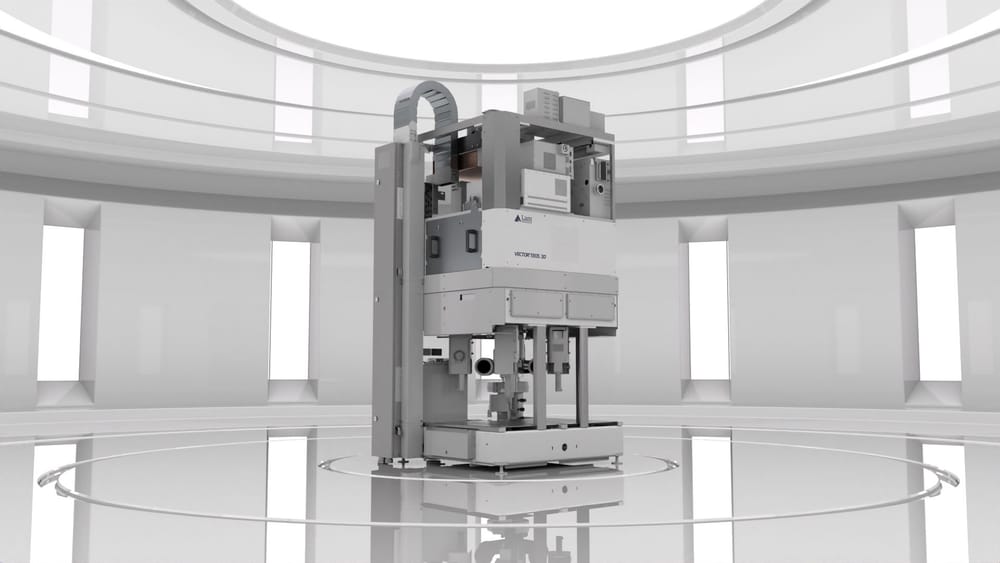Lumentum (LITE): Lighting the AI Datacenter Boom
Once a cyclical supplier of smartphone lasers, Lumentum has rebuilt itself around high-end optics for cloud and AI. With bets on co-packaged optics and a moat in indium-phosphide lasers, it is emerging as a structural winner of the AI data-center build-out.

Lumentum is a company built around light and the electronics that corral it with ruthless efficiency. Out of a quiet San Jose campus, it supplies the lasers, photonic chips and tightly packaged modules that let the internet breathe—across long-haul fiber routes, inside cloud data centers, and increasingly in the AI clusters that are bending network topologies to their will. After two years of painful resets in smartphones and telecom, it has reassembled itself for the next leg: a structurally higher mix of AI and cloud demand that makes the business less cyclical and more valuable.
The strategy has been simple but not easy. First came scale and high-end capability in coherent optics—the backbone gear used by carriers and cloud networks—via the acquisition of NeoPhotonics in 2022, which brought indium-phosphide expertise, coherent receivers, and integrated modules suited for 400G ZR/ZR+ and beyond. Then, in late 2023, Lumentum added Cloud Light, a fast-growing supplier of high-speed data-center transceivers, to pivot harder into the pluggable optics flooding hyperscalers’ halls. The two deals gave Lumentum depth in components and breadth in finished modules, plus a credible route into the highest-growth slices of the market.
The Moat and Financial Turn
If a moat exists in optical components—and investors debate that word in a world notorious for price compression—it looks like this: proprietary indium-phosphide laser design, vertically integrated packaging, and years-long customer qualifications that make switching painful when you’re threading light through chips at 200 gigabits per wavelength. Lumentum’s edge runs through externally modulated lasers, coherent receivers, ROADMs and amplifiers, and now the transceiver know-how from Cloud Light. The company’s April 2025 OFC briefing framed the total served “cloud-driven” market growing north of 25% annually, with leadership in “AI photonics” underpinning a >$3 billion annual revenue ambition as architectures push to lower power per bit. Those are bold claims, but they are grounded in the physics and in procurement reality: hyperscalers will pay for performance, power savings and reliability at scale, and they do not change optical suppliers lightly.

The financials show the turn. After a difficult fiscal 2024, fiscal 2025 revenue climbed to roughly $1.65 billion and swung to a modest GAAP profit as AI orders tightened fab utilization and Cloud Light’s contribution took hold. Management telegraphed still more capacity coming online and a mix shift toward the fastest lanes in the data center, a view echoed by industry trade coverage that flagged quarter-billion-plus sequential revenue ramps as AI demand accelerated. It is early innings, but the margin structure of high-end lasers and coherent components gives operating leverage when volumes improve.
The Co-Packaged Optics Opportunity
Prospects hinge on AI’s real plumbing. Training clusters and, increasingly, inference fabrics are straining copper links and even older optics. Every new GPU shelf needs more lanes, longer reaches, and better power budgets. Lumentum sits at three pressure points. Inside the data center, its EML-based transmitters and Cloud Light’s transceivers ride the migration from 800G to 1.6T pluggables, including 200-gigabit-per-lambda building blocks that hyperscalers are standardizing around. At the rack and switch level, the industry’s push toward lower-power architectures—linear-drive pluggables (LPO) now and co-packaged optics later—demands ultra-reliable lasers and tightly integrated receivers, both areas where Lumentum has invested and recently expanded U.S. manufacturing. And on the wide-area side, its coherent modules and ROADMs backstop the inter-data-center links that keep GPU islands synchronized. Each layer expands the company’s content per bit as networks re-architect for AI.
Competition remains heavy. Coherent Corp. (the combined II-VI/Finisar) is the other U.S. giant in lasers and datacom optics. Chinese vendors such as InnoLight, Accelink, and Hisense push hard at the transceiver layer, often with price as a wedge. Cisco’s Acacia and Ciena set the pace in coherent modules. The hyperscalers themselves are the wild card—some insource designs, many dual-source aggressively, and all pressure costs. But the market’s structure favors those who can repeatedly ship at the bleeding edge, qualify next-gen designs early, and keep yields high as wavelengths and symbol rates creep upward. Analyst work this year underscored that feared threats—chiefly, Nvidia’s push toward co-packaged optics displacing pluggables overnight—are likely to arrive in phases, not cliffs. That staggered adoption timeline gives component leaders like Lumentum oxygen to grow through the pluggable cycle while seeding content in co-packaged platforms.
The most important question for investors is how the data-center optics story compounds. In the near term, pluggables rule: 800G shipments are scaling, 1.6T is lining up, and linear-drive approaches can reduce DSP power and cost, but they still need premium lasers and receivers. Lumentum’s product mix here benefits twice—first via Cloud Light’s modules, second via the internal lasers and photonic components that feed them. Over the medium term, the company is positioning for co-packaged optics by touting ultra-high-power lasers built for switch-adjacent environments, the kind of parts that must run hot, last long, and fail almost never. In parallel, coherent ZR/ZR+ modules knit regional AI campuses together, and ROADMs let operators scale capacity without forklift swaps. This multi-vector exposure is why several sell-side shops have swung more positive this year and why management talks about “AI photonics” as a secular rather than cyclical uplift.
Co-packaged optics is the longer arc and the place where Lumentum’s laser franchise can compound into something meaningfully larger. Shifting the optics from pluggable modules at the faceplate to laser engines and receivers mounted next to the switching ASIC promises two things hyperscalers want: lower power per bit and higher faceplate density. The physics are favorable to the laser supplier. A co-packaged switch needs many more laser channels than today’s front-panel pluggables because reach and fan-out happen inside the chassis. Depending on architecture, a high-radix 51.2T or 102.4T switch can require on the order of 32 to 128 laser channels, each tested and binned for lifetime and stability in a hotter, electrically noisier neighborhood than a conventional module. That plays directly to Lumentum’s strengths in indium-phosphide design, reliability engineering and burn-in.
The revenue math gets interesting when you scale it. Assume that by the late 2020s hyperscalers begin deploying co-packaged optics in volume on the largest AI fabrics, first for top-of-fabric and spine layers. If industry shipments of 51.2T-and-above switches reach roughly one to one and a half million units annually around 2029–2030, and if co-packaged takes a quarter to a third of that mix in the high end, that suggests 250,000 to 500,000 co-packaged switches a year. With 48 to 96 laser channels per switch and an average selling price across single and arrayed ultra‑high‑power EMLs of roughly $50 to $80 per channel in the early waves, laser content alone lands between about $2,400 and $7,700 per switch. Multiply through and you arrive at a laser total addressable market that can plausibly reach up to $3.5 billion annually just at the switch layer before counting receivers, control ASICs and spares.
What portion of that could belong to Lumentum? The company’s share in high-performance EMLs and coherent light sources has historically been double‑digit with key cloud customers. If it captures 20% to 30% of early co‑packaged laser demand, that implies a revenue opportunity in the range of roughly up to $1.0 billion per year as the market ramps, with upside if adoption exceeds a third of high-end switches or if per‑channel pricing holds firmer due to the reliability demands of on‑package operation. The mix would also be richer than commodity pluggables: co‑packaged lasers shoulder tougher thermal and lifetime specs, lengthening qualifications and reinforcing switching costs.
The adoption curve won’t be a cliff. Pluggables continue to dominate leaf and much of the spine through 1.6T, and linear‑drive pluggables will buy time by trimming DSP power. But as rack power budgets tighten and AI fabrics sprawl across more GPUs per rack, the case for co‑packaged strengthens. Lumentum’s playbook is to keep shipping the pluggable cycle at scale while seeding the co‑packaged lane with ultra‑high‑power lasers, reliability data and joint development agreements, so that when hyperscalers cross the line, it is already inside the BOM. On that trajectory, co‑packaged optics is less a threat to today’s revenue than a second engine that can extend growth into the next architecture cycle.
The Legacy Products
Risks are not theoretical. A large chunk of Lumentum’s history is tied to 3D-sensing VCSELs in smartphones, a market that can whipsaw in a single product cycle; that exposure is smaller as datacom grows, but it hasn’t vanished. Price competition is relentless, and any yield wobble in new 200-gigabit-per-lambda engines can erase margins quickly. China is both an opportunity and a geopolitical risk vector, especially for transceivers. And while everyone in optics talks about “power-per-bit,” customers ultimately buy systems, not components; if hyperscaler road maps consolidate around a rival’s laser platform or a different modulation scheme, content assumptions can change. What tempers those risks is Lumentum’s integration of design, packaging and manufacturing on a technology node—indium phosphide—that rewards experience, and the simple fact that hyperscalers prefer not to single-source what keeps their clusters alive.
Conclusion
The upside case for Lumentum runs through the AI data center. Think of a 2026-era hall: racks of accelerators linked with ever-fatter optical cables, top-of-rack to spine to super-spine, and a second network layer dedicated to AI fabrics. Every step leans more on light. Lumentum’s opportunity is to sell more content into each layer—EMLs and receivers inside pluggables now, UHP lasers and integrated photonics inside co-packaged assemblies later—while its coherent portfolio expands the capacity of the metro and long-haul links that stitch campuses together. The company’s own targets, paired with capacity additions and the contribution from Cloud Light, signal a business that can be bigger, more diversified, and structurally higher margin than the pre-AI Lumentum. If AI is a race against resistance—power, heat, distance—then photons win on physics, and suppliers who ship the right photons, reliably, win on economics. On that score, Lumentum looks positioned to be one of the clear structural winners of the AI data-center boom.
Author

Investment manager, forged by many market cycles. Learned a lasting lesson: real wealth comes from owning businesses with enduring competitive advantages. At Qmoat.com I share my ideas.




